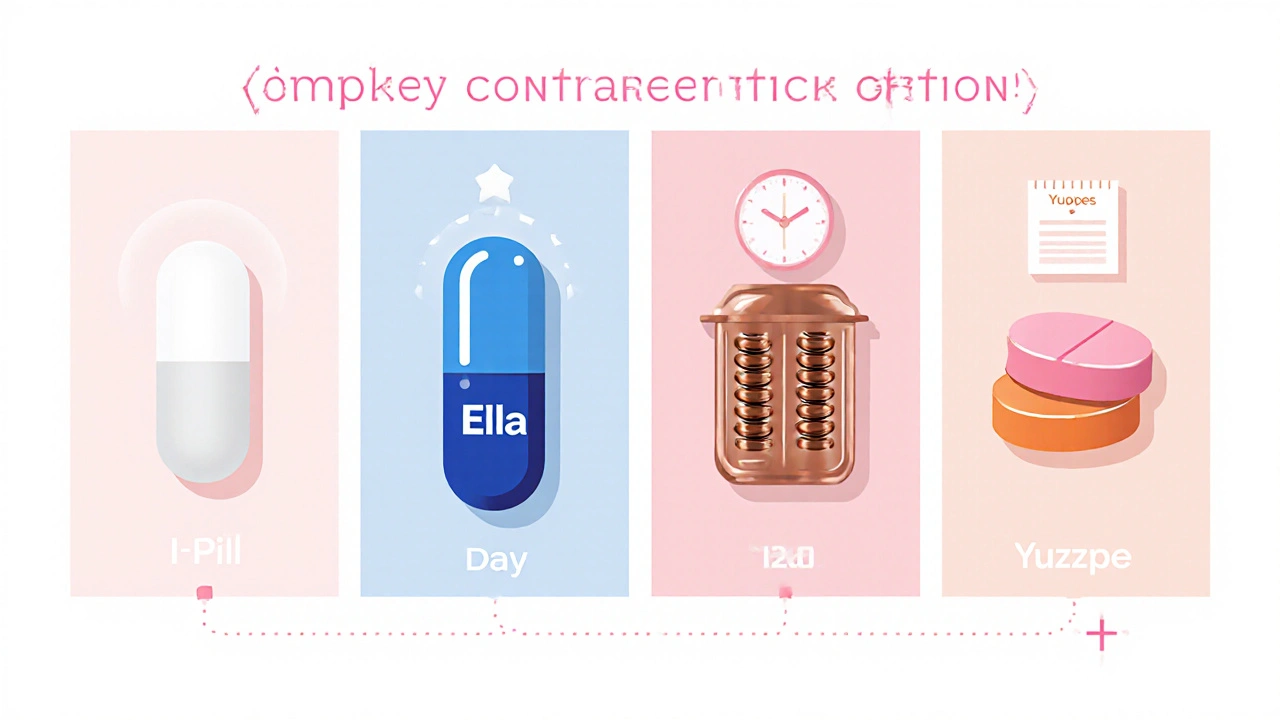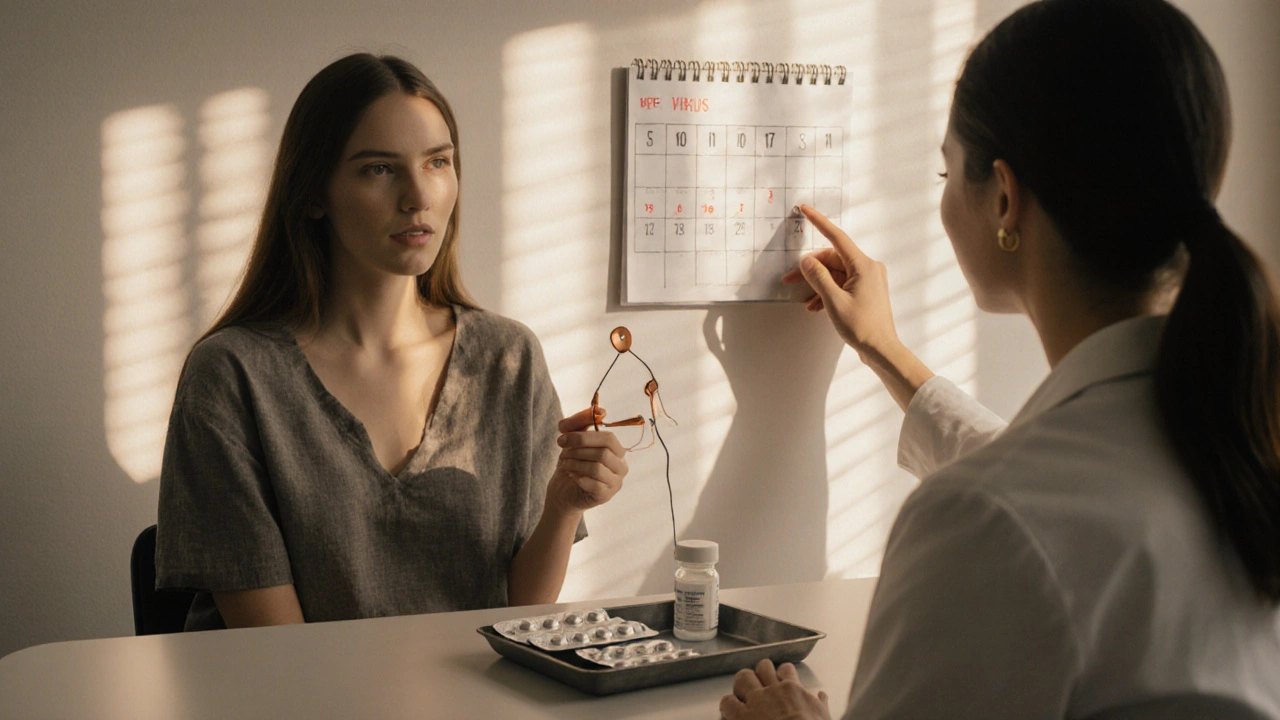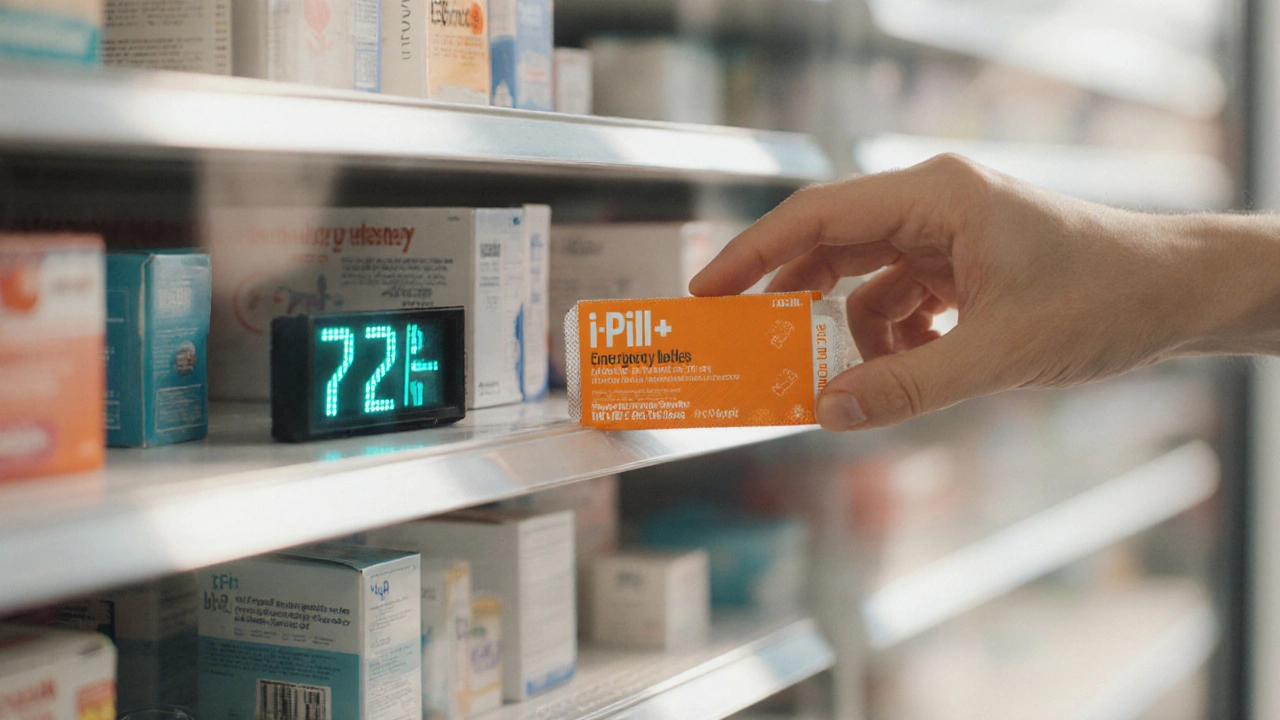Emergency Contraception Selector
Recommended Emergency Contraception Options
I-Pill
Levonorgestrel-based pill
95% effective in 72h windowElla
Ulipristal acetate
85% effective up to 120hCopper IUD
Device insertion
99%+ effectiveYuzpe Regimen
Combined pills
75% effective in 72hKey Takeaways
- The I-Pill (levonorgestrel) is most effective within 72hours and works best before ovulation.
- Ulipristal acetate (Ella) remains effective up to 120hours and may be better for later‑stage dosing.
- The copper IUD can prevent pregnancy up to 5days after intercourse and offers long‑term contraception.
- Yuzpe regimen (combined oral contraceptives) is the least convenient and has higher nausea rates.
- Cost, prescription requirements, and side‑effect profiles vary widely, so personal circumstances dictate the best choice.
If you’ve ever wondered how the I-Pill stacks up against other emergency contraception choices, you’re not alone. Women across Australia and beyond often face a split‑second decision after unprotected sex, and the right pill-or device-can make a huge difference in preventing an unwanted pregnancy. This guide walks through the science, the timing, the price tags, and the real‑world pros and cons of the most common options available in 2025.
Understanding Emergency Contraception
Emergency contraception (EC) is a backup method designed to stop a pregnancy after unprotected intercourse or birth‑control failure. It works by either delaying ovulation, preventing fertilisation, or hindering implantation. The effectiveness of any EC method drops sharply the longer you wait, which is why timing is a critical factor in every comparison.
In Australia, EC can be obtained over‑the‑counter (OTC) in pharmacies, via prescription, or through a clinician‑inserted copper IUD. The choice often hinges on how quickly you need protection, your health profile, and how comfortable you are with pills versus a device.

The I-Pill (Levonorgestrel)
I-Pill is a levonorgestrel‑based emergency contraceptive pill that you can buy OTC at most pharmacies without a prescription. Levonorgestrel, a synthetic progestogen, works primarily by inhibiting or delaying ovulation. If taken within 72hours of intercourse, it prevents pregnancy in about 85-95% of cases; effectiveness falls to roughly 58% when taken between 72-120hours, which is why the label recommends use as soon as possible.
Typical dosage: a single 1.5mg tablet (or two 0.75mg tablets taken 12hours apart). Common side effects include mild nausea, fatigue, headache, and temporary changes in menstrual timing. Most users experience a bleed‑through or earlier period, which can be reassuring that the hormone kicked in.
Alternative Emergency Contraception Options
While the I-Pill is the most widely known, several alternatives offer different benefits:
- Ulipristal acetate (brand name Ella) is a selective progesterone receptor modulator that can be used up to 120hours after sex. Its effectiveness stays above 85% even at the 5‑day mark, making it the go‑to choice for later dosing.
- Copper IUD (commonly known as ParaGard) can be inserted within 5days of unprotected intercourse and provides >99% protection. It also serves as a long‑term birth‑control method for up to 10years.
- Yuzpe regimen involves taking a high dose of combined oral contraceptive pills (ethinyl‑estradiol + levonorgestrel) in two doses 12hours apart. Effectiveness is roughly 75% within 72hours, but nausea and vomiting are common.
Each option has its own regulatory status in Australia. Ulipristal requires a prescription, while the copper IUD must be inserted by a trained clinician. The Yuzpe method can be done with OTC combined pills but is less convenient due to dosage complexity.
Head‑to‑Head Comparison
| Attribute | I‑Pill (Levonorgestrel) | Ulipristal (Ella) | Copper IUD | Yuzpe Regimen |
|---|---|---|---|---|
| Effective Window | Up to 72h (best), 72‑120h reduced | Up to 120h (maintains >85% efficacy) | Up to 120h (99%+ efficacy) | Up to 72h |
| Mechanism | Delays ovulation | Blocks progesterone receptors, delays ovulation | Spermicidal copper, prevents fertilisation & implantation | High‑dose estrogen + progestin, delays ovulation |
| Prescription Needed | No (OTC) | Yes (pharmacy prescription) | Yes (clinical insertion) | No (OTC combined pills) |
| Typical Cost (AU$) | ~30-40 for one pack | ~70-90 per tablet | ~350-450 (including insertion fee) | ~15-25 for required pills |
| Side‑Effects | Nausea, headache, menstrual change | Less nausea, possible fatigue, menstrual spotting | Cramping, heavier periods, rare perforation | Significant nausea, vomiting, breast tenderness |
| Long‑Term Contraception | No | No | Yes (up to 10years) | No |

Choosing the Right Option for You
Here’s a quick decision guide based on common scenarios:
- Need fast, OTC protection within 3 days? The I‑Pill is the simplest choice.
- Encountered unprotected sex 4‑5 days ago? Ulipristal or a copper IUD are your only high‑efficacy bets.
- Looking for both emergency and ongoing birth control? A copper IUD kills two birds with one stone.
- Prefer to avoid a prescription? I‑Pill or Yuzpe regimen (if you already have combined pills) are viable.
- Very sensitive to nausea? Ulipristal tends to cause the least gastrointestinal upset.
Always discuss any hormonal history, liver issues, or recent pregnancies with a pharmacist or doctor. Certain medications-like enzyme‑inducing anticonvulsants-can lower levonorgestrel effectiveness, nudging you toward ulipristal or IUD options.
Practical Tips for Using Emergency Contraception
- Take the pill as soon as possible; delays cut efficacy dramatically.
- If you vomit within 2hours of swallowing, repeat the dose (consult a pharmacist).
- Follow up with a pregnancy test at least 2weeks after dosing, especially if your period is late.
- Remember that EC does NOT protect against sexually transmitted infections-use condoms for that.
- Store pills in a cool, dry place; heat can degrade hormone potency.
Frequently Asked Questions
Can I use the I‑Pill if I’m already pregnant?
No. The I‑Pill works by preventing or delaying ovulation; it cannot terminate an existing pregnancy. If you suspect you’re already pregnant, seek medical advice for appropriate care.
Is the copper IUD safe for teenagers?
Yes. Studies in Australia and the UK show the copper IUD is safe for adolescents with proper screening. It avoids hormones, which some younger users prefer.
What if I miss a dose of the Yuzpe regimen?
Missing the second dose reduces effectiveness to about 50%. Take the missed tablet as soon as you remember, then consult a pharmacist about backup options.
Do any of these methods affect my regular contraceptive pill schedule?
Levonorgestrel EC can slightly shift your next period, but it won’t interfere with ongoing combined pills. If you’re on a progestin‑only regimen, take the EC pill and then resume your regular schedule after a short pause as advised by your GP.
Is there any age limit for using ulipristal?
Ulipristal is approved for people 12years and older in Australia, provided a prescription is obtained. Younger teens should discuss options with a healthcare professional.


Dawna Rand
October 6, 2025 AT 15:16Hey there! 🌈 If you’re weighing the I‑Pill vs. Ella, remember timing is everything – the sooner, the better. 🎯 And don’t forget the copper IUD is a powerhouse if you need long‑term protection!
Effie Chen
October 6, 2025 AT 15:25The 72‑hour window really is the sweet spot for levonorgestrel; beyond that, its efficacy drops to around 58%, so if you’re past that mark, Ella or a copper IUD become the go‑to options.
rohit kulkarni
October 6, 2025 AT 15:50Consider, if you will, the underlying biological principle: emergency contraception functions primarily by altering the endocrine cascade that governs ovulation; thus, any agent that delays the luteinizing hormone surge-be it levonorgestrel, ulipristal, or the copper milieu-serves the same ultimate purpose: preventing fertilisation.
RONEY AHAMED
October 6, 2025 AT 16:40Bottom line: pick what’s easiest for you right now-if you can get a pill over the counter, the I‑Pill works fast; if you’re okay with a doctor visit, the copper IUD gives you both emergency and ongoing protection.
emma but call me ulfi
October 6, 2025 AT 16:50Totally agree, it’s all about convenience and what feels right for your body.
George Gritzalas
October 6, 2025 AT 17:05Wow, thanks for the PhD lecture-who knew preventing a pregnancy could be so… poetic?
Alyssa Matarum
October 6, 2025 AT 17:46Ulipristal stays above 85% even at 120 hours; the I‑Pill falls under 60% after 72 hours.
Lydia Conier
October 6, 2025 AT 19:26Hey lovely folks! 🌟 Let’s break down the whole emergency contraception maze so nobody feels lost. First off, the I‑Pill (levonorgestrel) is super handy because you can grab it off the shelf without a prescription, but its magic is strongest in the first three days after intercourse. After that, the effectiveness takes a nosedive, so if you’re thinking “maybe I’m still good after 4 days,” you’re probably overestimating its power. This is where Ella (ulipristal acetate) shines – it works up to five days and keeps its punch above 85% even at the tail end. The copper IUD, on the other hand, is the heavyweight champion: insert it within five days and you get over 99% protection, plus you get up to a decade of birth control for free. Yes, you have to see a clinician and pay a bigger upfront fee, but many find the long‑term payoff worth it. If you’re already on combined oral contraceptives, you can use the Yuzpe regimen, but be prepared for some serious nausea – it’s the least convenient option. Side‑effects differ: levonorgestrel can cause a brief upset stomach or a slightly earlier period, ulipristal usually gives mild fatigue, the IUD may cause cramping and heavier periods, and the Yuzpe combo often brings the dreaded “chemo‑like” nausea. Cost‑wise, the I‑Pill is the cheapest, Ella sits in the middle, and the IUD is the most expensive upfront but cheapest per year. Remember to check if any meds you’re on, like certain anti‑seizure drugs, can lower the pill’s effectiveness – in that case, the IUD or ulipristal are safer bets. Also, if you have a history of severe hormonal reactions, the copper IUD gives you a hormone‑free alternative. For teens, the IUD is safe after proper screening, so don’t let age be a barrier. And finally, always follow up with a pregnancy test about two weeks later if your period is late, no matter which method you chose. Stay informed, trust your body, and know that help is always just a pharmacy or clinic away! 🌈
ruth purizaca
October 6, 2025 AT 19:28Another option? Just ask your pharmacist.
Shelley Beneteau
October 6, 2025 AT 19:30I appreciate the thorough rundown; it makes the decision feel less overwhelming.